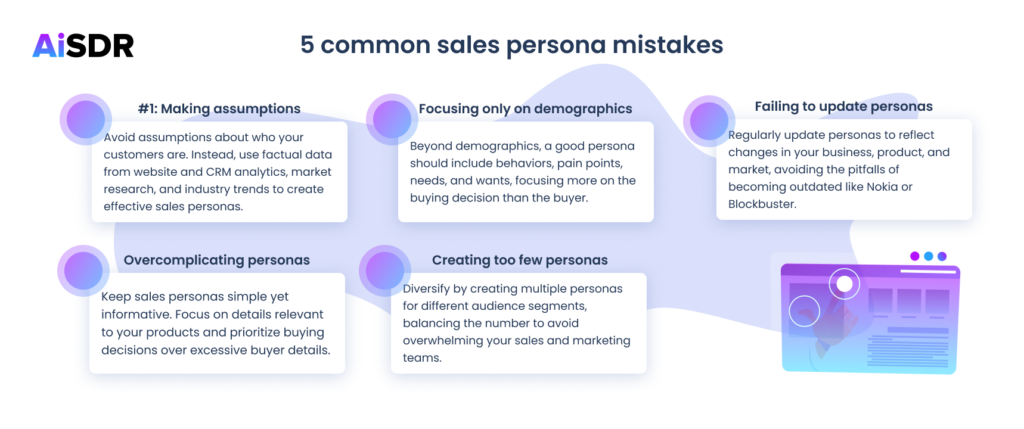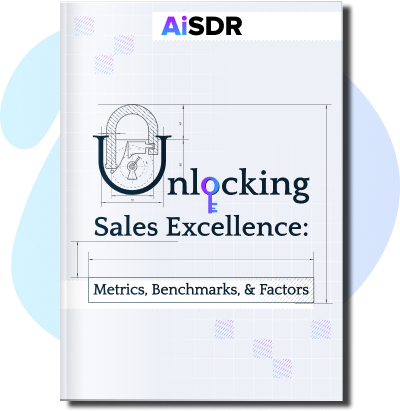5 Rookie Sales Persona Mistakes You Definitely Want to Avoid

Want to supercharge your sales? Make sure not to repeat these 5 rookie sales persona mistakes
What if there was a surefire way to turbocharge your sales and marketing efforts while also fine-tuning your product lineup and driving your earnings? Little do you know, but chances are high you already have it in your back pocket.
The sales persona.
Every successful business creates one near the start of their life, but simply having one is not enough. Not only will you need several, but you need to make sure they’re done right.
Previously, we discussed why you need a buyer persona and how to create one. This time, we’ll highlight the most common sales persona mistakes and how to avoid them.
But before we get down to it, here’s a recap of why a buyer persona is essential to your business strategies.
Persona & ICP recap
A well-developed sales persona or ideal customer profile (ICP) can fuel the growth of your business in three key areas:
- Product development – A deep understanding of your customers and target companies allows you to create products that truly meet their needs and preferences.
- Marketing – Your sales persona or ICP will help you craft compelling content, run successful marketing campaigns, and devise effective targeting strategies.
- Sales – Buyer personas and ICPs offer a great foundation for lead qualification, sales pitches, presentations, and objective handling.
Sales personas and ICPs are crucial for your business, but merely having them isn’t enough. A bungled persona or ICP may deliver the opposite of what you want: wasted resources, product failures, and revenue loss.
5 common sales persona mistakes
Not all sales personas are created equal. To get it right, keep your eyes peeled for these five common mistakes.
Mistake #1: Making assumptions
Assumptions have led too many people astray. Instead of asking outright, we assign thoughts, feelings, and motivations to other people. And we all know too well how that ends, especially in personal relationships.
But the business realm is no different. Your sales personas will never be effective if you create them based on who you think or wish your customers are.
Instead of making wrong assumptions, why not rely on factual customer data? You can dig up some reliable info from the following sources:
- Website analytics – Tools like Google Analytics can give you a glimpse into the behavioral patterns of your website visitors. You’ll learn a lot about your customers from the web pages and blogs they visit the most. You will also get to know the demographics attracted to your brand.
- CRM analytics – Your company’s CRM also offers in-depth profiles and behavioral patterns that can help you profile your ideal customer. Here, you can gather information about your customers’ preferred products, annual expenditures, and expected lifetime value.
- Market research – Understand your customers’ needs and preferences by running surveys, interviews, focus groups, and observational research.
- Industry trends – Explore the latest customer trends in your industry by analyzing statistics provided by reliable sources, including Statista, Gallup, and Google Public Data Explorer.
Data-driven sales personas will help you forge real and lasting relationships with your customers and cater to their actual, not assumed, needs. The relationships you build may, in turn, lead to unexpected deals thanks to word-of-mouth, recommendations, or simple networking.
Mistake #2: Overcomplicating personas
With rich data at your disposal, it can be tempting to create sales personas that are too specific and detailed. But such personas could get too complex to be useful.
While it makes sense to create an avatar of a single person, adding too many details can make your sales persona overwhelming for the teams expected to use it. To avoid this, stick to details that are relevant to your products. For instance, marital status won’t matter as much for CRM providers as it would for florists.
Strive for a brief yet informative sales persona that offers just the necessary insights for your teams.
It’s a tricky balancing act. So, here’s a helpful tip: focus on the buying decision, not the buyer. Use these questions as a guide:
- What compels customers to buy the solutions you offer? Do they value quality over price? Or is it price over quality?
- What personal or business improvements will buyers get by using your solution?
- What perceived barriers or concerns might make your customers decide you are not the right provider for them?
- Which obstacles along the buyer’s journey could lead your customers to turn down your offerings?
- Which aspects of your competitors’ offerings might compel your customers to choose them?
Brainstorm the answers and filter out irrelevant details. Brief, straightforward sales personas will be most valuable to your teams and double as a great prompt for AI marketing solutions like AiSDR. You’ll be churning out AI-generated content in no time.

Mistake #3: Focusing only on demographics
Most sales personas focus on demographics, highlighting the target buyer’s age, gender, geographic location, educational background, and socioeconomic status. You can gather this data through market research or by harvesting the CRM profiles of existing customers.
Demographic data segments your target audience into narrower subcategories, offering a solid foundation for your sales persona. Though important as they are, demographics are not the be-all and end-all of a good persona.
A well-developed persona focuses less on the buyer and more on the buying decision. It covers the customers’ behaviors, pain points, needs, and wants.
At AiSDR, we help our customers craft personas and ICPs. Through discussions and follow-up questions, we capture all essential data before shaping and structuring it for use as a prompt that allows the AiSDR AI sales tool to generate compelling content.

Mistake #4: Creating too few personas
You can turbocharge your sales persona by targeting a specific audience segment. But then, this might restrict your sales and marketing efforts. You won’t maximize your revenue capture by marketing to a niche audience.
At first, you might be tempted to broaden your persona. However, this will cause the effectiveness of your targeting strategy to drop once more.
There’s a better tactic. Instead, create additional personas, each one capturing a different segment. You should also create separate persona prompts for your inbound approaches and your outbound strategy.
That said, crafting too many personas can be just as harmful. You risk spreading your sales and marketing teams too thin and making their efforts less effective.
When branching out, remember that each new persona is the same as opening a new channel or adopting a new tactic. So, before adding one, think about these questions:
- Will the additional business strategy generate more revenue?
- Do I have the resources needed to implement this strategy?
Skip adding a persona if it shares too many attributes with existing ones and is unlikely to generate enough extra revenue to cover the costs.
Mistake #5: Failing to update personas
Сhange is inevitable. Your business grows, your product evolves, and the market shifts. It is only logical that your sales persona will have to keep up with these changes. Otherwise, you’ll become yet another business dinosaur driven to extinction.
Nokia and Blackberry, the former consumer electronics giants, failed to keep up with the evolution of smartphones and consumer demands. Blockbuster was also left behind when the market shifted to streaming services.
Failing to update your ideal customers and how you serve them will put you on the same path of irrelevancy.
Craft sales personas that work for your business
Creating a sales persona takes time and effort. What’s more, you have to design an even more resource-intensive business strategy around that persona.
But don’t get hung up on developing a perfect, bullet-proof persona. Chances are you’ll make a mistake somewhere. That’s just the nature of personas – You’ll need to revisit them from time to time so that you can adjust them using recent data and insights.
If you’re stuck and not quite able to put the finishing touches on your persona, the AiSDR customer support team will answer all your questions and provide advice and best practices on how to build a high-performing persona that grants your team more bandwidth for critical work.
Book a demo with AiSDR to see how small changes in personas can lead to big improvements in content.
FAQ
How can I guarantee my personas are accurate?
Do thorough user and market research to ensure that your personas are accurate. This way, you will avoid false assumptions and keep your persona data-driven.
What should I include in my sales personas?
Your sales persona must include demographics and psychographics. The former covers basic information, such as age, gender, location, and educational and career background. The latter details the customer’s pain points, motivators, needs, and preferences.
What if I don’t have enough data to create my sales personas?
In that case, explore external data, such as the stats and insights from market research and industry trends. You can do interviews, surveys, focus group sessions, or observational research with your target audience or prospects. Try digging up some data, too, from reliable sources like Statista, Gallup, or Google Public Data Explorers.
How often should I update my personas?
It depends on the type of business you run. A good rule of thumb is to check in twice a year.











